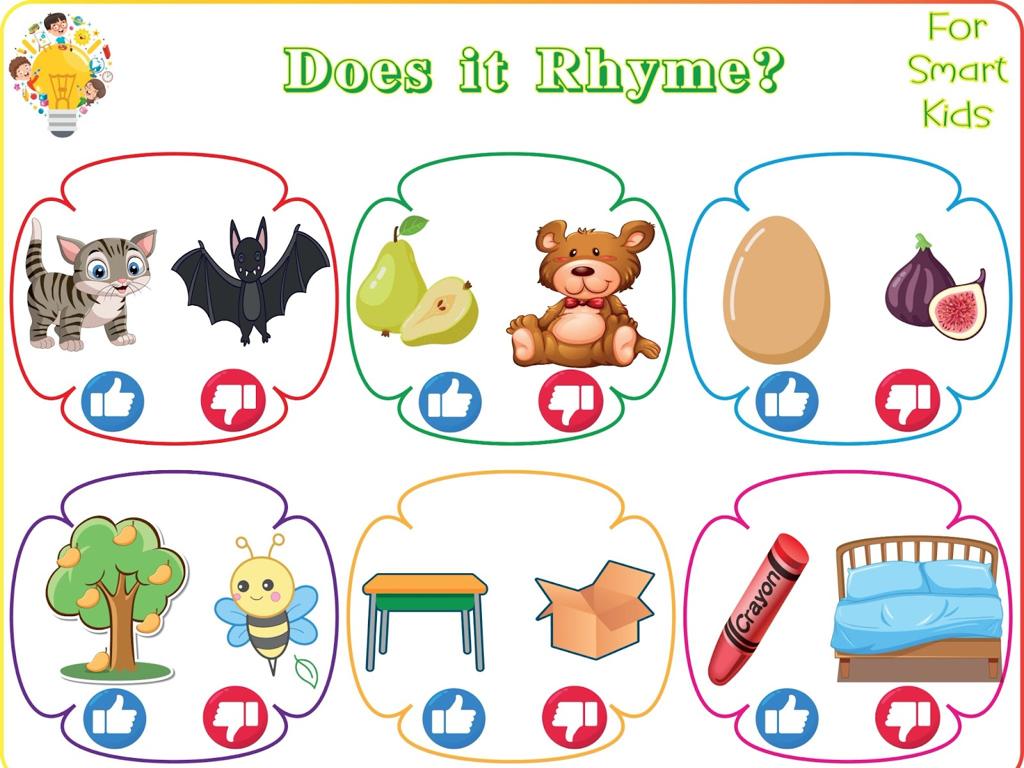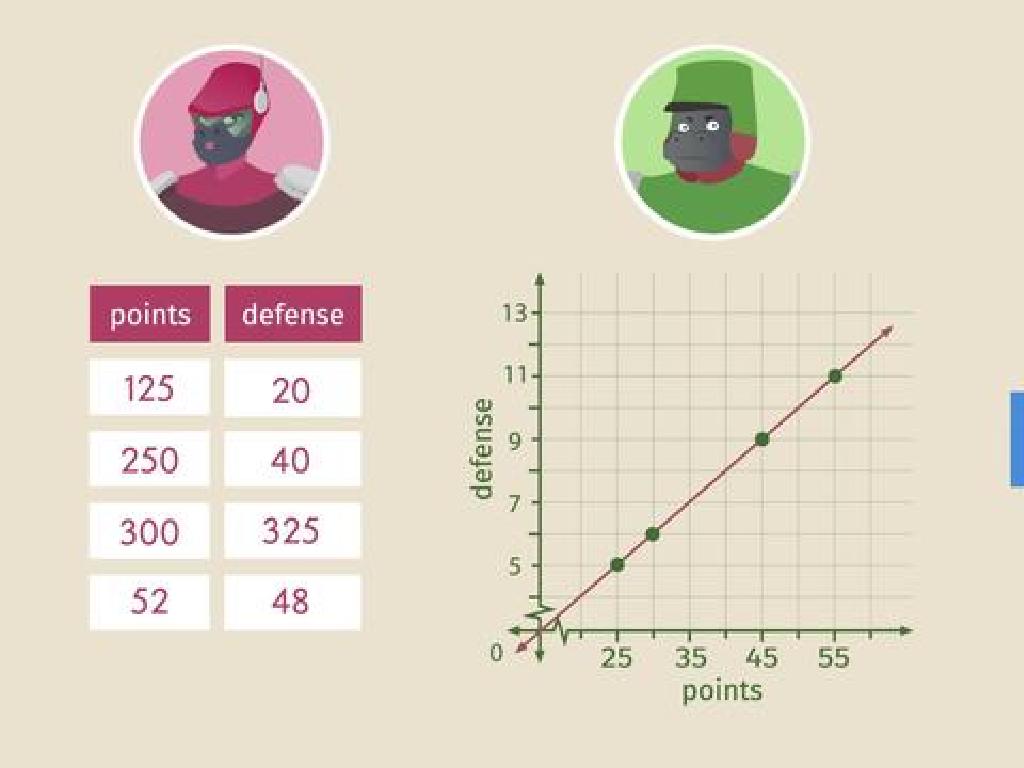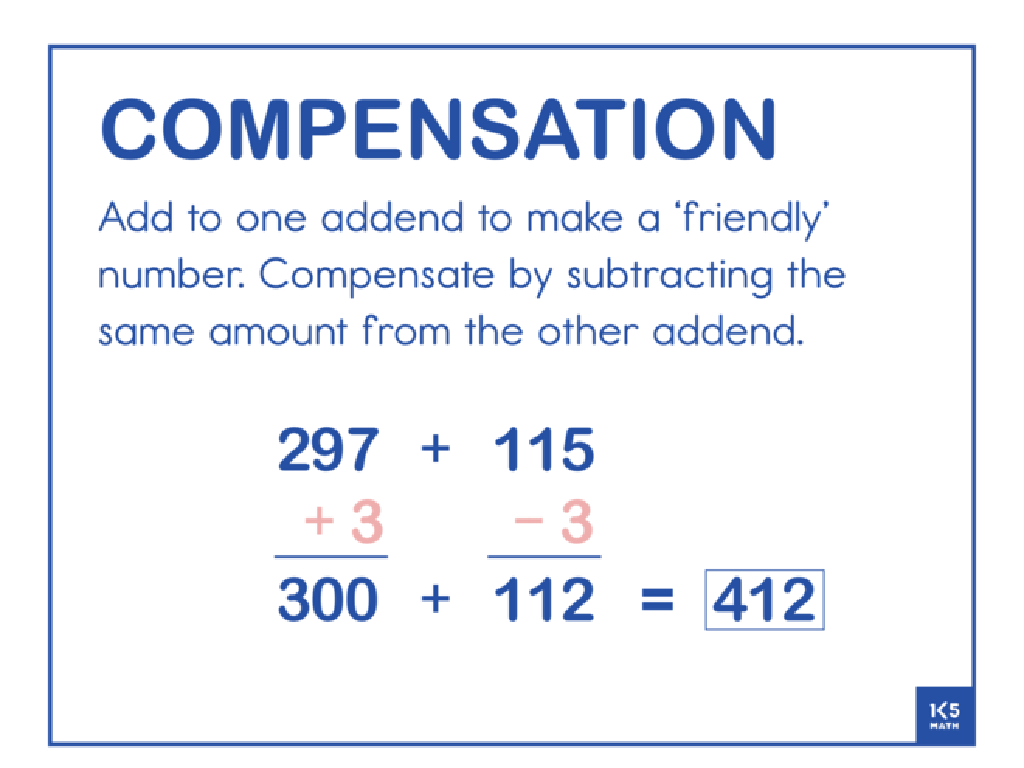Graph Decimals On Number Lines
Subject: Math
Grade: Fourth grade
Topic: Relate Fractions And Decimals
Please LOG IN to download the presentation. Access is available to registered users only.
View More Content
Graphing Decimals on Number Lines
– Understand fractions and decimals
– Fractions are parts of a whole, decimals are another way to show them
– Differences and relationships
– Fractions have numerators/denominators, decimals have points
– Today’s focus: Graphing Decimals
– Learn to place decimals on a line with marks
– Practice with examples
– Example: Graph 0.5 between 0 and 1 on the line
|
This slide introduces students to the concept of graphing decimals on number lines, a key skill in understanding the relationship between fractions and decimals. Begin by explaining that fractions represent parts of a whole and decimals are another way to express these parts. Highlight the differences and similarities between the two, such as how fractions use numerators and denominators while decimals use points to separate whole numbers from fractional parts. Use the number line as a visual aid to show how decimals fit between whole numbers, and provide examples for the students to graph. Encourage students to think of a number line as a street where decimals live between the houses (whole numbers). This will help them visualize and better understand the concept. Prepare to have students practice with number lines and support them as they learn to accurately place decimals.
Understanding Decimals
– Decimals represent fractions
– Like fractions, decimals show parts of a whole number
– ‘Point’ separates whole & part
– The decimal point is key: it comes after the whole number part
– Example: 0.5 equals 1/2
– Half of a whole is 0.5, just like half a pie
– Example: 0.75 equals 3/4
– Three quarters, like 3/4 of a pizza, is 0.75
|
This slide introduces the concept of decimals to fourth-grade students, explaining that decimals are another way to represent fractions. Emphasize the role of the decimal point in separating the whole number from the fractional part. Use familiar examples like half and three-quarters to illustrate the concept with everyday items such as pies and pizzas. This will help students visualize and better understand the relationship between fractions and decimals. Encourage students to think of other examples of halves and quarters in their daily lives to reinforce the concept.
Understanding Decimals on Number Lines
– What is a number line?
– A straight line with numbers at equal spaces
– Number lines show order of numbers
– Representing decimals on number lines
– Points on lines match to decimals, like 0.5 or 1.25
– Comparing decimals with number lines
– See which decimals are bigger or smaller by their position
|
This slide introduces the concept of a number line and its use in understanding the order and value of numbers, including decimals. A number line is a visual representation that helps students grasp the concept of number placement and value. When teaching this slide, explain that just like whole numbers, decimals can also be placed on a number line. Show how to plot decimals between whole numbers, emphasizing that the space between each whole number can be divided into ten equal parts for tenths, hundred equal parts for hundredths, etc. Use examples like 0.3 or 1.75 and demonstrate how to find their position on the number line. Encourage students to practice by plotting various decimals themselves and using number lines to compare the size of different decimals.
Placing Decimals on a Number Line
– Find whole numbers around the decimal
– If you have 3.7, it’s between 3 and 4
– Divide the section into ten parts
– Imagine cutting a cake into 10 equal slices
– Count the parts for your decimal
– For 3.7, count 7 slices from 3
– Mark the decimal on the line
– Place a dot above the 7th slice to show 3.7
|
This slide is aimed at helping students understand how to graph decimals on a number line. Start by identifying the whole numbers that the decimal falls between. For example, 3.7 is between 3 and 4. Next, explain that the space between these whole numbers should be divided into ten equal parts, representing the tenths place in a decimal. Then, students will count over the number of parts that corresponds to their decimal. For 3.7, they would count over seven parts from the number 3. Lastly, they will mark the decimal on the number line. Use visual aids to demonstrate this process, and provide several examples for practice.
Graphing Decimals on a Number Line: Example 0.3
– Understand 0.3 is between 0 and 1
– Just like fractions, decimals show parts of a whole
– Divide the line into ten equal parts
– Each part is a tenth because 0.3 is tenths
– Count three parts from zero
– Starting at zero, move to the right for 3 tenths
– Place a dot above the third mark
– The dot represents the decimal 0.3 on the line
|
This slide is aimed at helping fourth-grade students visualize the placement of the decimal 0.3 on a number line. Begin by explaining that decimals represent parts of a whole, similar to fractions. Emphasize that since 0.3 has one decimal place, it is in the ‘tenths’ place, so the number line should be divided into ten equal parts between 0 and 1. Guide students to count three equal parts from zero to the right and place a dot above the third mark to represent 0.3. Reinforce the concept by having students practice with other decimals like 0.5 or 0.7, ensuring they understand the process of dividing the number line and accurately placing decimals.
Let’s Practice Together: Graphing Decimals
– Graph decimal 0.7 on a number line
– Find the whole numbers around 0.7
– 0.7 is between 0 and 1 on the number line
– Divide the segment into 10 equal parts
– Each part represents 0.1; count 7 parts from 0
– Place 0.7 accurately on the number line
– 0.7 is marked after the 7th division from 0
|
This slide is a class activity to help students understand how to graph decimals on a number line. Start by explaining that decimals represent parts of a whole and can be placed between whole numbers. Show them how to find the two whole numbers that the decimal is between, in this case, 0 and 1. Then, guide them to divide the segment between these numbers into 10 equal parts, as each part represents a tenth (0.1). Finally, instruct them to count 7 parts from 0 to accurately place 0.7 on the number line. Encourage students to practice with different decimals and to check their understanding by asking questions. Possible activities include graphing various decimals, comparing their positions, and even creating their own number lines with different scales.
Activity Time: Graph Your Own Decimals
– Receive a worksheet with number lines
– Graph the given decimals
– Place each decimal on the correct point
– Work in pairs for better understanding
– Discuss the process with your partner
– Help each other with the task
– Share tips and strategies as you work
|
This activity is designed to provide hands-on experience with graphing decimals on number lines. Distribute worksheets with pre-drawn number lines to the students. Announce the decimals they need to graph, ensuring a range of difficulty across the examples. Encourage students to work in pairs to foster collaborative learning and peer assistance. As they work, circulate the room to offer guidance and support. Possible activities for differentiation: 1) Have advanced students graph more complex decimals, 2) Provide manipulatives for tactile learners, 3) Offer a mini whiteboard session before the activity for visual learners, 4) Allow struggling students to use a number line with marked decimals as a reference, 5) Challenge quick finishers to create their own number lines and decimals for their peers to graph.
Class Activity: Decimal Number Line Race
– Work in groups for a number line race
– Each group gets unique decimals to plot
– Place your decimals on the number line
– Use your knowledge of decimals to find the right spot
– First group to finish correctly wins!
|
This interactive class activity is designed to help students understand the concept of placing decimals on a number line. Divide the class into small groups and provide each group with a large number line and a set of decimal numbers. Each group will have a different set of decimals to ensure a fair challenge. The goal is for students to work together to correctly place each decimal on the number line as quickly as possible. The first group to finish with all decimals correctly placed wins the race. This activity encourages teamwork, reinforces the concept of decimal placement, and adds a fun competitive element to the learning process. Possible variations of the activity could include using different ranges on the number lines, timing each group to beat their previous times, or having students explain their reasoning for the placement of each decimal.
Review: Graphing Decimals on Number Lines
– Recap on graphing decimals
– Open floor for questions
– Sharing insights from learning
– Maybe share how to place 0.5 or 0.75 on a number line
– Emphasize practice importance
|
This slide is aimed at reviewing the concept of graphing decimals on number lines. Start by summarizing the key points of the lesson. Encourage students to ask questions if they’re unsure about any part of the lesson or to clarify any doubts. Create an interactive environment where students can share what they’ve learned or any strategies they’ve found helpful. Remind them that mastering graphing decimals takes practice, and encourage them to continue practicing at home. As a teacher, be prepared to provide additional examples or to go over the concept again if necessary. Consider having a few students come up to the board to demonstrate their understanding by graphing specific decimals on a number line.
Homework: Exploring Decimals on Number Lines
– Complete the worksheet provided
– Observe decimals in daily life
– Look for prices, measurements, or time
– Graph your decimal observations
– Use a number line to plot the decimals you find
– Share your findings in class
|
This homework assignment is designed to reinforce the concept of graphing decimals on number lines. Students are expected to complete the ‘Decimal Number Line’ worksheet to practice their skills. Additionally, they should observe decimals in real-world contexts such as money, measurements, and time, and then graph these on a number line to visualize their placement. Encourage students to be creative in finding decimals in their environment. In the next class, students will have the opportunity to share their findings, which will help them understand the practical application of decimals and enhance their presentation skills. Provide examples of how to graph decimals on a number line and remind them to pay attention to the correct placement of decimals.






